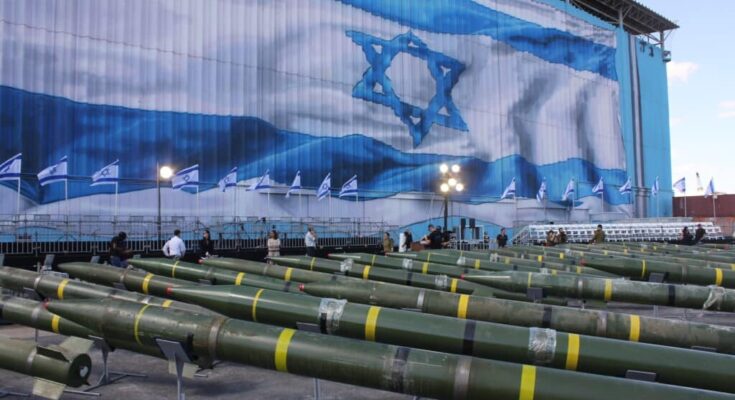
The Middle East is on the verge of a regional war. Following the assassination of Hezbollah Leader Hasan Nasrallah and Israel’s ground operation in Lebanon, Iran responded by firing two hundred missiles at Tel Aviv. Seeing these events unfold, the international community has expressed its concern about how Israel will react and the consequences of this.
It should be noted that Tel Aviv is maintaining two other open fronts, one in Gaza and the other in Lebanon, where it is continuing its aerial bombardments. Meanwhile, the US is trying to get the two sides to agree on a ceasefire. The concern of the international community is whether Israel will target Tehran’s nuclear facilities.
How can Israel respond to Iran’s attack?
Iran’s attack was described as a response to repeated attacks by Israel. The Iranian Revolutionary Guards said the missile strikes were focused on Israeli security targets. There is a great deal of concern about the possibility of Israel attacking inside Iran and against their nuclear facilities. Former Israeli Prime Minister Naftali Bennett has urged Israel to retaliate by destroying Iran’s nuclear program.
Israel is likely monitoring Iran’s nuclear facilities as it debates its response to Tehran’s missile attack, according to Malcolm Davis, a senior defense strategist at the Australian Strategic Policy Institute.
“From Israel’s point of view, it cannot allow Iran to acquire nuclear weapons. There would certainly be strong pressure on Netanyahu’s cabinet to attack these nuclear facilities and essentially suspend the Iranian nuclear weapons program, possibly for years,” Davis told CNN’s Becky Anderson.
Middle East: Three possible scenarios in how Israel will respond to Tehran
According to Forward.com, given the scale of the Iranian challenge, Israel now faces three possible courses of action:
- A standard response: According to this scenario, Israel would respond to Iran’s ballistic missile strike but only symbolically. A limited low-risk response could satisfy some of Israel’s immediate security concerns but would do little to deter Iran or disrupt its broader strategic ambitions. This is the path of least resistance, but it is unlikely to change the status quo. For Israel, that may no longer be enough.
- A tactical strike: A more substantial response could involve direct military action against Iranian assets, such as oil facilities or military installations. This would aim to cause real damage to Iran’s infrastructure, forcing it to reconsider further provocations. An attack on an oil facility, for example, could disrupt Iran’s economic lifelines and send a clear message that Israel will not tolerate continued missile attacks. The goal would be to create enough pain for Iran to deter future actions.
- A strategic reshuffling of the balance of power in the region: The third option is far more ambitious and fraught with risks, but it could reshape the Middle East. Israel would somehow pressure the West to enforce the law on Iran, demanding not only an end to its missile attacks, but also the complete dismantling of its nuclear program and an end to its sponsorship of proxy forces throughout the region.
In the third scenario, Israel, or preferably, from its perspective, the US and other Western allies, could blockade Iranian ports, destroy key oil facilities, and even use bombs that would disable bunkers so as to cripple Iran’s nuclear capabilities.
This could also include providing significant support to Iranian opposition groups, further destabilizing the regime in Tehran. The overall objective would be not just to contain Iran but to bring about regime change or at least counter its ambitions.
Middle East: Iran’s arsenal
According to a CNN report, Tehran has thousands of ballistic and cruise missiles with various ranges. The exact numbers for each type of missile are unknown. However, US Air Force General Kenneth Mackenzie told Congress in 2023 that Iran has “over 3,000” ballistic missiles, according to a report this year by the Wisconsin Project on Nuclear Arms Control’s Iran Watch website.
The ballistic missiles’ trajectories carry them out of or near the boundaries of Earth’s atmosphere before the warhead payload separates from the missile that carried it into the sky and plunges back into the atmosphere. Weapons experts who analyzed verified social media videos of the scene told CNN that Iran used variants of the Shahab-3 ballistic missile in the latest attack on Israel.
The Shahab-3 is the basis for all of Iran’s medium-range ballistic missiles that use liquid fuel, according to Patrick Senft, research coordinator at Armament Research Services (ARES). The Missile Threat Project says the Shahab-3 entered service in 2003, can carry 760 to 1,200 kilograms (1,675 to 2,645 pounds) of warhead and can be launched from mobile launchers as well as silos.
New variants in Iran’s armory
Iran Watch says the newer variants of the Shahab-3, the Ghadr and Emad missiles, have an accuracy of up to 300 meters (nearly 1,000 feet) from their intended targets. Iranian media reported that Tehran used a new missile, the Fattah-1, in the attacks. Tehran describes the Fattah-1 as a “supersonic” missile, meaning it travels at Mach 5 or five times the speed of sound (about 3,800 miles per hour, or 6,100 kilometers per hour).
According to analysts, almost all of the country’s ballistic missiles reach supersonic speed during their flight, especially as they dive toward their targets. The term “supersonic” is often used to refer to so-called supersonic glide vehicles and supersonic cruise missiles: highly advanced weapons that can maneuver at supersonic speed within the Earth’s atmosphere. This makes it extremely difficult to shoot down such weapons.
Middle East: Israel’s missile defense systems
On the other hand, Israel has a number of countermeasures to be able to prevent attacks ranging from ballistic missiles to cruise missiles and rockets. Its main weapon is the Iron Dome system, which is used to counter incoming missiles and artillery weapons. However, the Iron Dome is the lowest layer of Israel’s missile defense and is not the system that would have been used to combat the ballistic missiles fired on Tuesday night, according to the country’s Missile Defense Organization (IMDO).
The next step up in missile defense is David’s Sling, which protects Israel against short- and medium-range threats, according to the IMDO. David’s Sling, a joint project of the Israeli advanced defense system RAFAEL and US defense giant Raytheon, uses Stunner and SkyCeptor kinetic interceptor strikes to neutralize targets up to 186 miles away, according to the Missile Threat Project of CSIS.
Above David’s Sling are Israel’s Arrow 2 and Arrow 3 systems, jointly developed with the United States. Arrow 2 uses fragmentation warheads to destroy incoming ballistic missiles in their final phase as they dive toward their targets in the upper atmosphere.
The Arrow 2 has a range of 56 miles and a maximum altitude of 32 miles, according to the Missile Defense Advocacy Alliance, which called the Arrow 2 an upgrade of the US Patriot missile defense systems once used in that role by Israel. Arrow 3 uses hit-to-kill technology to intercept incoming ballistic missiles from space before they reenter the atmosphere to hit their targets.



